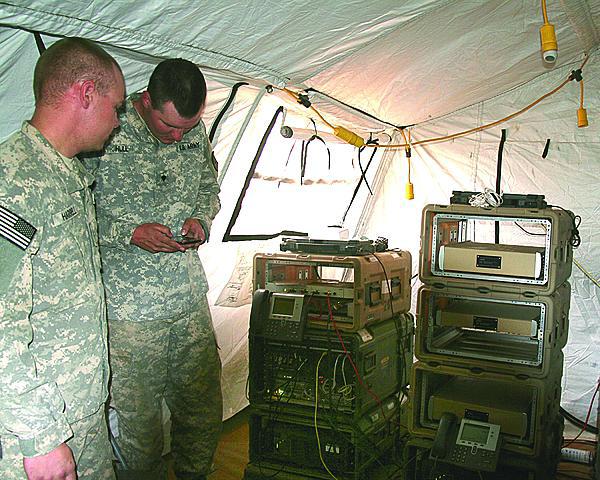Awaited Technologies About to Become Reality for Warfighters
The U.S. Army is extending advanced communications to disadvantaged users, fielding a series of capabilities to various groups in an effort to give soldiers at the pointy end of the spear the connectivity they need. With the rollout, forward-deployed troops should be able to access classified networks via wireless 4G long-term evolution connections. National Guard units also are acquiring the tools to aid their troops in disaster response scenarios.
Known as Tactical Network Transmissions (TNT), the project is a direct Army requirement with six separate capabilities included. They are: a transportable line-of-sight radio system called TRILOS; the Tropo Lite terminal, which bounces microwaves off the atmosphere to work around line-of-sight and satellite issues; 4G long-term evolution; Wi-Fi; radio bridging and voice cross banding; and the Mission Network Enclave (MNE) that can reconfigure to connect to the coalition network, secret Internet protocol router network (SIPRNet), nonsecure Internet protocol router network (NIPRNet) or commercial Internet and phone service. Most of the time, the 4G and Wi-Fi features will run together, with both linked to the same security stack so troops can access SIPRNet and NIPRNet on their devices using either method. Even SIPRNet will run over commercial software, not encryption devices.
The TNT was fielded to the 86th Expeditionary Signal Battalion (ESB) for use during the Network Integration Evaluation (NIE) 14.2 in May. The ESBs support missions in austere environments where connectivity is difficult, generally supporting other units without communications. With the evaluation complete, the current Army plan is to feed TRILOS and Tropo Lite into programs of record while the other four capabilities move into the Joint Network Node (JNN) as associated support items of equipment.
The 4G, Wi-Fi, MNE and radio-bridging/cross-banding capabilities are combining to form the Joint Incident Site Communications Capability (JISCC) Delta Package. “A JISCC is essentially a JNN augmented with JISCC Delta Packages,” explains Lt. Col. Joel Babbitt, USA, product manager for Warfighter Information Network-Tactical (WIN-T) Increment 1, the organization in charge of the project.
Those packages are important to enable communication during situations, such as hurricane response, when power, cell towers and commercial Internet all have failures. Radios might work, but often the groups responding are on devices through which they cannot interoperate. The JISCC will provide immediate 4G and Wi-Fi, commercial Internet and radio-bridging functions so whoever responds can communicate. General Internet options are important for reaching out to organizations such as the Red Cross.
Fielding to the National Guard will commence in the third quarter of fiscal 2015 and continue through 2019 or until all 54 states and territories have a package. “Now, that’s not the only place these capabilities are going,” Col. Babbitt says. “There’s a number of different places these will be going.”
Through WIN-T Increment 1, the Wi-Fi will field to tactical operations centers (TOCs), and 4G will replace user access cases at forward operating bases (FOBs). That work likely will commence in fiscal 2016. The remaining four capabilities will field to ESBs through the Signal Modernization Program. With the MNEs, the brigades will be able to establish coalition networks quickly, offering faster, more robust international interoperability on the battlefield.
Who will receive the technologies initially will depend on future missions. They may trickle into Afghanistan with troops who will be in the country for the nonkinetic missions scheduled to continue. Typically, systems go first to units heading to theater. “We just don’t know at this point in time,” Col. Babbitt explains.
The TNT pieces will reduce time and materiel. Current setups require personnel to lay down flooring and Ethernet cables in TOCs as well as to run cables to the forward outposts. In some cases, that effort demands digging trenches for 300-meter cable. Eliminating those cables saves significant work for signal troops. The wireless effort will be demonstrated at NIE 15.2. Col. Babbitt hopes to showcase how much less time will be necessary to establish the operations centers. “Every signal soldier I have ever talked to about this is just about ecstatic because they’re the poor folks who actually have to set up all this cabling,” he says. Wi-Fi will replace 25-foot cable while the 4G replaces the 100-meter and 300-meter varieties.
Size, weight and power all should see reductions. The Army should trim more than 1,000 transit cases out of the Increment 1 baseline as well as experience a 12 to 15 percent weight reduction with the TNT pieces. By 2020, the weight will go down even more, from the current 600 pounds to a target of 90 to 100 pounds. Col. Babbitt says that change depends on a next generation of servers not yet available. “That tells you the revolutionary impact on the TOC,” he adds.
Tropo Lite and TRILOS offer similar savings. TRILOS is a small grouping of transit cases that can fit into a single truck and trailer, down from two of each necessary for the high-capacity line-of-sight system it replaces. At the same time, the new system has 12 times the capacity. Tropo Lite needs three to four transit cases and offers four times more throughput than what troops currently have.
Capt. Adrian Smith, ARNG, JISCC project lead, explains that with the capabilities, users pay less for bandwidth. By performing the functions without employing satellites, the military can avoid leasing necessary bandwidth or even using bandwidth the government already owns. Tropo Lite has a farther range than TRILOS, but TRILOS offers faster transmissions. Whether or not the TNT technologies eventually play into bring-your-own-device (BYOD) policies is out of the scope of the program. However, at the recent Army evaluation, soldiers had the MNE working in its commercial role on the backside of the 4G and Wi-Fi, running for morale, welfare and recreation purposes at the mess tent for the 2nd Brigade Combat Team, 1st Armored Division. Col. Babbitt states that, “They had BYOD, not so much a policy, but that’s what they were doing.” Soldiers could access the local Wi-Fi on their smartphones to run various apps.
Though WIN-T Increment 2 has been a major focus for recent NIEs as the Army worked to prepare it for fielding, Increment 1 is being implemented now and will reach approximately 90 percent of the service branch. “This basically allows us to be a platform for innovation,” the colonel explains. Any updates to Increment 1 can spread quickly to the entire tactical Internet “because we basically are the entire tactical Internet—the expeditionary network anyway,” he adds. “That’s why you’re seeing this move out quickly.”
Development of the TNT project has taken about a year and a half, though work on transmissions that have fed into the program began as early as 2011. Efforts on JISCC also have been underway since 2011. At that time, the Guard began doctrine, organization, training, materiel, leadership and education, personnel, and facilities assessments.
Even as it prepares for rollout and transition activities, the TNT program is waiting on final results from the NIE. Some planned activities moving forward include refinements to the 4G and Wi-Fi user log-ons. Col. Babbitt says the MNE and bridging capabilities are basically complete and should be fielding nearly as-is, with improvements over time.







Comments